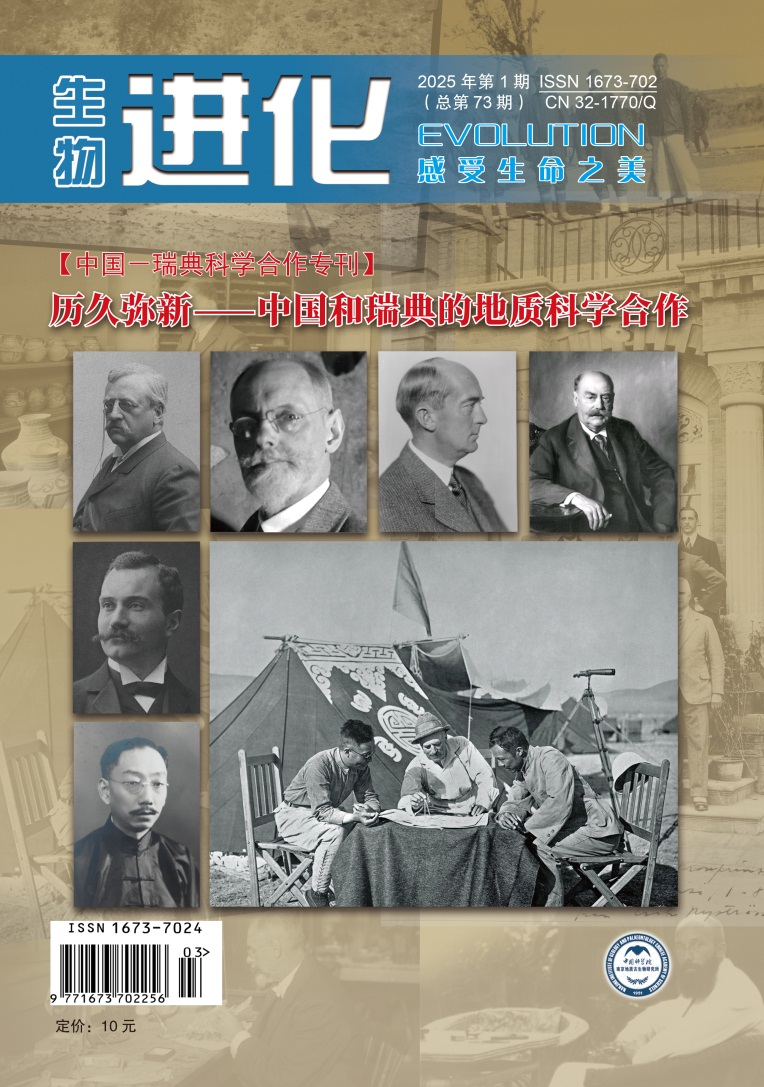
(转载)系列专题:历久弥新——中国和瑞典的地质科学合作 第一期
历久弥新——中国和瑞典的地质科学合作
文/ 斯蒂芬·麦克洛克林(Stephen McLoughlin) 刘丽萍
瑞典国家自然历史博物馆古生物部
本文原载于《生物进化》杂志2025年第1期“中国-瑞典科学合作特刊”
2025年是中华人民共和国和瑞典王国建交75周年,也是周口店北京猿人首次公布99周年。在这一重要的历史节点,《生物进化》编辑部特别策划了“中国-瑞典科学合作”专刊,回顾 两国在20世纪初期科学合作中取得的辉煌成就,并展现这一遗产对当代研究工作的深远影响。
20世纪初,中国的现代科学刚刚起步,吸引了众多的欧美学者。而在当时的瑞典,地质学家们野外考察的重点还聚焦在各大陆的未知区域,尤其在各国竞相瞄准的极地区域,瑞典已经成功进行了几次大规模的科学考察。但是,在1914年约翰·贡纳尔·安特生(Johan Gunnar Andersson)受聘成为北洋政府的矿业顾问后,瑞典就转入了一个与中国合作的新时代。瑞典专门成立了“中国委员会”——旨在为中国和瑞典的研究人员筹集在中国的野外经费,领导和协调双方的合作。瑞典的王储,后来的国王古斯塔夫六世在很长一段时间里担任了这个委员会的主席。中国的工作由安特生和地质调查所所长丁文江主持,瑞典的中国委员会则召集瑞典国家自然历史博物馆、斯德哥尔摩大学和乌普萨拉大学等科学机构与中国开展科学合作。三家单位派出数名科学家,和中国同事并肩投身于野外工作中。他们在中国采集发掘的化石都被送回瑞典鉴定和研究。为此,自然历史博物馆和乌普萨拉大学专门成立了新的研究团队。按照两国签订的协议,这些运往瑞典研究鉴定的化石材料,完成鉴定后由两国平分,所有相关的研究成果,首先要发表在当时新设立的《中国古生物志》上。
这些科学合作和交流,为双方提供了一个共赢的局面。一方面,瑞典的研究人员从一个还未充分开发的新区域获得大量的野外资料和研究材料;另一方面,中国可以获得其现代化工业基础急需的自然资源。瑞典科学家的工作包括地质调查、填图、标本采集和创新性的研究。他们的投入,使中国的地学研究直接从启蒙跨入国际前沿。更为重要的是,随着地质、古生物、考古和古人类各种新材料的发现,带来了动物地理和动植物演化对气候变化响应的新思考。
今天,中国和瑞典之间在地学领域的合作仍然充满活力。自20世纪50年代以来,双方进行了广泛的合作,在21世纪,合作有了显著的增加。仅到瑞典自然历史博物馆访问的中国专家就涵盖了脊椎动物、无脊椎动物和古植物学的各个方面,双方合作发表了至少50篇研究论文。
本期特刊集合了中国和瑞典学者撰写的6篇文章,展示了瑞典科学家对中国科学发展的历史贡献,及两国之间正在进行的合作。这些文章详细介绍了安特生、赫定、赫勒、师丹斯基、维曼和林奈的非凡贡献,提供了了解这些历史人物和成就的新视角,也延续了两国间百年的科学合作传统,进一步强调了这种伙伴关系在推动科学创新、增强国际友谊和应对全球挑战方面的重要性。
我们希望本期特刊能够成为读者了解中瑞科技合作历史和现状的窗口,为未来更深层次的合作、成果共享奠定坚实的基础。我们期待中、瑞在未来几十年里继续开展富有成效的合作。

The enduring collaboration in Geoscience between Sweden and China
Stephen McLoughlin ,Liping Liu
Department of Paleobiology ,Swedish Museum of Natural History
The year 2025 marks the 75th anniversary of the establishment of diplomatic relations between the People’s Republic of China and the Kingdom of Sweden, and the 99th anniversary of the first announcement of ‘Peking Man’. At this historical juncture, the editorial board of Evolution of Life has organized a special issue on “China-Sweden Scientific Cooperation” to review the remarkable achievements of early 20th-century collaborations between the two nations and to highlight the enduring impact of this legacy on contemporary research.
In the early 20th Century ,modern science in China was in its infancy ,attracting numerous scholars from Europe and America. At the same time ,geologists from Sweden were carrying out several large-scale field expeditions to all continents of the world. The chief focus was on polar regions,as these had been little-studied and were prime regions for international exploration at the time. However ,in 1914, Johan Gunnar Andersson was hired as mining adviser to the Chinese Government and established a new era of scientific collaboration between China and Sweden. The China Committee (CC) was established to secure funding for both Swedish and Chinese fieldwork, and to lead and coordinate the collaboration. The CC was chaired by the Swedish Crown Prince, later King Gustaf VI Adolf. On the Chinese side, the work was led by Andersson and Ding Wenjiang, head of the Geological Survey of China. The Committee brought the Swedish Museum of Natural History (NRM), Stockholm University (SU) and Uppsala University (UU) into the scientific collaboration with China. These institutions sent out several scientists to the field where they worked side by side with Chinese colleagues. The fossil collections that they accumulated were sent to Sweden for identification by new research teams at NRM and UU. After determination, and following previous agreements, the material was shared equally between the two nations and the results jointly published in a new scientific journal, Paleontologica Sinica, which was founded in China at the time.
These scientific exchanges offered a “win-win” circumstance for both partners, as the Swedish research community discovered a new niche that gave them access to extensive field data from an under-explored region through partnership with a nation keen on developing its natural resources and establishing a modern industrial base. The contributions from these scientists included geological surveys, cartographic work, specimen collection, and groundbreaking research. These efforts also propelled Chinese science from its nascent stage to the global forefront. Moreover, along with the geological, palaeontological, archaeological and paleoanthropological discoveries in China, new questions emerged concerning climate changes related to the biogeography and evolution of floras and faunas deep in Earth’s history.
Today ,scientific collaboration between China and Sweden remains vibrant. There has been extensive collaboration since the 1950s ,but linkages have notably increased in the 21st Century. For example,visiting researchers to NRM from China have been specialists in various aspects of vertebrate and invertebrate palaeontology and palaeobotany and have produced at least 50 research articles.
This special issue features six articles authored by Chinese and Swedish scholars that showcase the historical contributions of Swedish scientists to the development of Chinese science while highlighting the ongoing collaboration between the two nations. These articles delve into the extraordinary contributions of Johan Gunnar Andersson, Sven Hedin, Thore Halle, Otto Zdansky, Carl Wiman, and Carl Linnaeus. The authors not only continue the century-old tradition of scientific cooperation but also offer fresh perspectives on these historical achievements and figures. It underscores the importance of such partnerships in driving scientific innovation, fostering international friendship, and addressing global challenges.
We hope this special issue serves as a window for readers to explore the history and current state of China-Sweden scientific cooperation and lays a solid foundation for deeper collaboration and shared achievements in the years to come. We look forward to fruitful collaboration between Sweden and China into the coming decades.
附件下载: